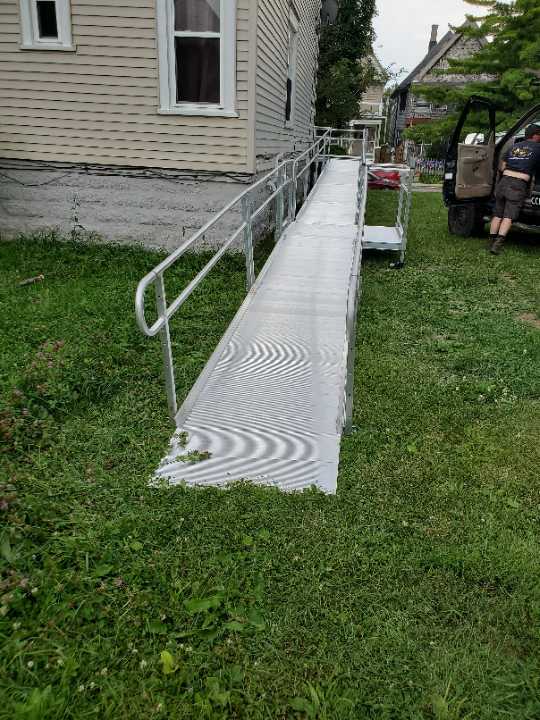Get Funding for a Residential Wheelchair Ramp
We understand that purchasing a wheelchair ramp for the home can be a large financial undertaking for some families, but we don’t want that to be the reason your family doesn’t get the access solution they deserve.
Our goal for this article is to clarify exactly how to get funding for a residential ramp in the hopes that it makes the funding process easier.

Insurance
While ramps are necessary for individuals with mobility challenges, a ramp or access solution is not always covered by insurance for a variety of reasons. Here’s why and how you can find insurance that does cover a ramp:
Medicare:
There are two parts to Medicare coverage: Part A covers “Hospital Insurance” and Part B covers “Medical Insurance.” Wheelchair ramps fall under the category for durable medical equipment (DME) covered by Part B, just like a wheelchair. However, a wheelchair ramp is not reimbursable like a wheelchair is, even if a physician prescribes it as medically necessary. This is because wheelchair ramps do not “directly treat a medical condition.”
However, you may be able to receive financial assistance through Medicare Advantage. Medicare Advantage plans are required to provide the same benefits as Part A and B as Original Medicare (or traditional Medicare), but may also offer additional coverage. These plans are only offered by private insurers, so they differ by company, plan, and location. You’ll need to ask a private insurance agent specifically about their Medicare Advantage policies to determine financial assistance policies and compare coverage.
Medicaid:
Wheelchair ramps are classified as durable medical equipment (DME) under Medicaid as well. This is a federal program for low-income seniors and individuals with disabilities and is administered at the state level. So, policies will also vary by state.
There are two ways to obtain coverage for a wheelchair ramp under Medicaid: 1) regular Medicaid 2) Home and Community Based Services (HCBS) Waivers. Regular Medicaid guarantees benefits for qualified individuals. That means that a wheelchair ramp can be covered by Medicaid if it is deemed medically necessary. While possible, it is generally very difficult to get a wheelchair ramp ruled as medically necessary. The better option for Medicaid is likely going to be an HCBS Waiver.
In many states, Medicaid Waivers pay for the cost of ramps, as they are considered home modifications or environmental adaptations. See a state by state list of Medicaid Waivers and their benefits here.
Non-Profit Assistance
The nonprofit route is a great option for non-Veterans who want to get funding for a wheelchair ramp. There is often less red tape with this route and the non-profit will do all of the heavy lifting so you don’t need to do much work outside of the initial application. Check out this list of national nonprofits that help with funding a wheelchair ramp:
AccessABILITY Experience
The Ability Experience (formerly Push America) charity from Phi Beta Kappa runs their own AccessABILITY program that is specifically for low-income families to help them get a wheelchair ramp. The non-profit organization supports each project with a $1000 grant for materials and helps to organize the volunteer labor.
Rebuilding Together
Rebuilding Together helps with home modifications and safety improvements for Veterans and other individuals in need. Projects they help with include installing wheelchair ramps, handrails, outdoor lighting, and other home modifications to help a family enter and exit the home safely.
National Directory of Home Modification Repair Resources rogram
The University of Southern California publishes a directory of programs that assist seniors with the expenses associated with the construction of a wheelchair ramp. Search the comprehensive directory by state to locate programs and resources in your area.
Centers for Independent Living
You can also search for local centers for independent living that offer support and guidance for individuals with disabilities in your area. They operate as a resource for finding local organizations that assist with the cost of a wheelchair ramp.
Assistance for Veterans
One option for Veteran assistance is to apply for coverage through TRICARE for Life to supplement Medicare Part B which would pay the remaining 20% co-payments not covered by Medicare. However, you would have to get Medicare to agree to pay for the wheelchair ramp first, which can be difficult as we mentioned earlier. The better option would be to see if you qualify for the Veteran-Directed Home and Community Based Services Program (VD-HCBS).
The VD-HCBS is designed to provide assistance for Veterans who are candidates for assisted living placements to receive the same level of care in their own home. Here is a brief overview of the qualifications:
Age: none
Health: must require “nursing home level care”
Marital Status: individuals who live alone may have an easier time going through the process, but having a spouse in the home does not make you ineligible for receiving assistance
Location: must live in a home and cannot reside in a nursing home or in an assisted living facility. There are 77 programs in 42 states and veterans are allowed to travel from the home area to participate.
Financial: there are no requirements for financial status
Veteran Service Discharge: required to have had 24 months of continuous active duty and a discharge status other than Bad Conduct or Dishonorable to be eligible for VA Health Care.
